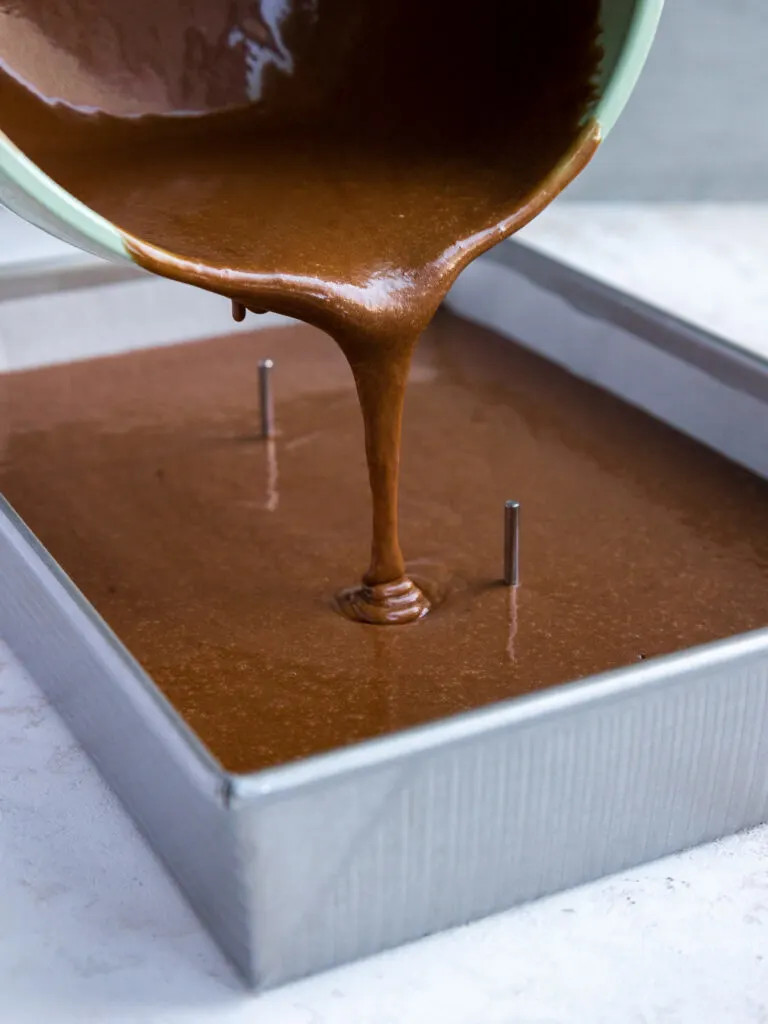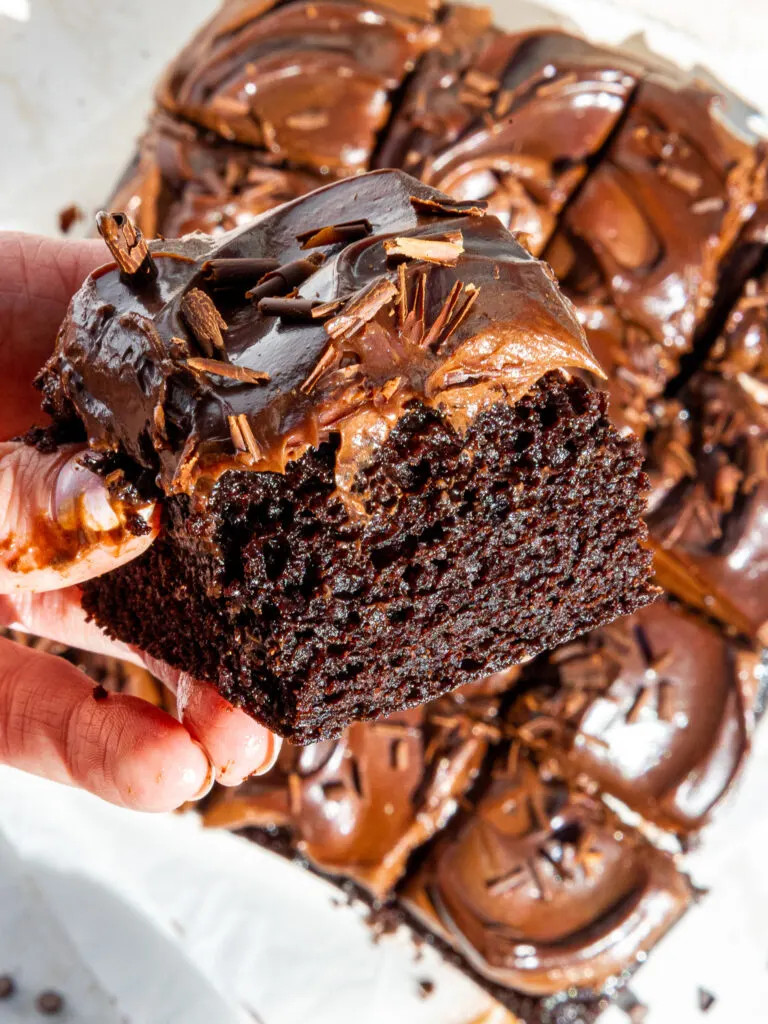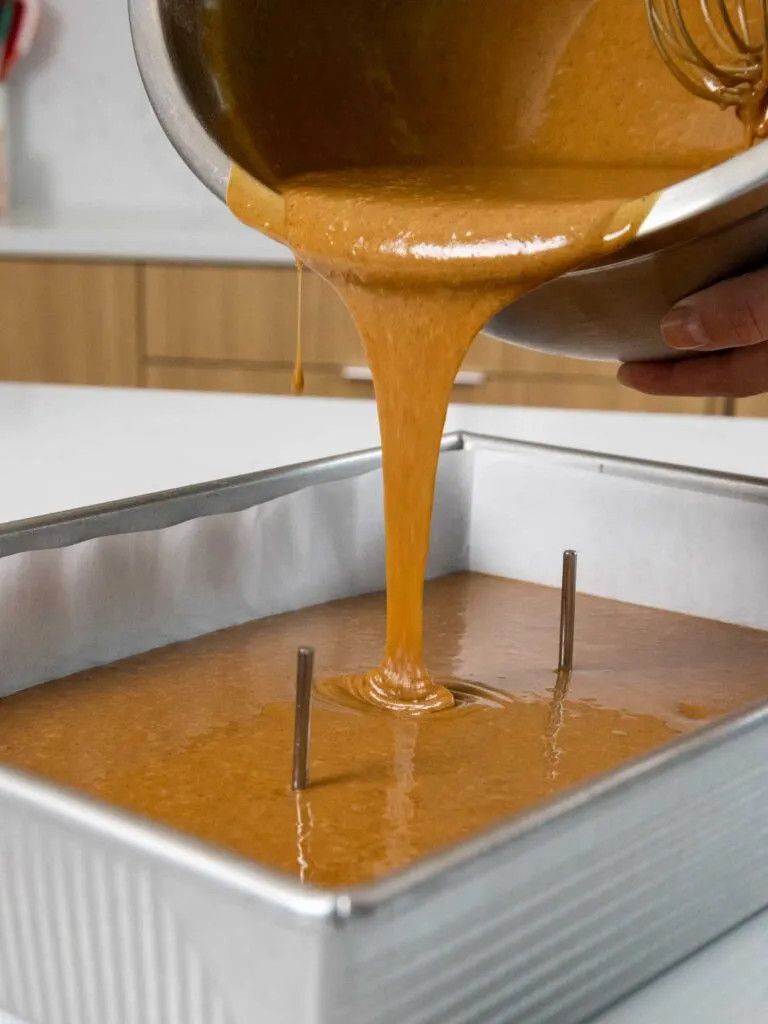Sheet cakes are a fantastic choice for gatherings of all sizes, from intimate family celebrations to large parties. One of the most common questions when planning to bake or order a sheet cake is: “How many servings will I get?” This guide focuses specifically on 1/2 Sheet Cake Servings to help you determine the perfect cake size for your needs.
First, let’s clarify what a 1/2 sheet cake actually is and how it compares to other standard sizes. There are three main sizes of sheet cakes that bakers frequently use: the quarter sheet, the half sheet, and the full sheet.
- Quarter Sheet Cake: Approximately 9×13 inches
- Half Sheet Cake: Approximately 13×17 inches
- Full Sheet Cake: Approximately 16×24 inches
While pan sizes can vary slightly, these dimensions are generally accepted as standard.
 image of chocolate cake batter being poured into a quarter sheet cake pan
image of chocolate cake batter being poured into a quarter sheet cake pan
Understanding Cake Layers and Serving Sizes for a 1/2 Sheet Cake
Before we dive into the specific number of 1/2 sheet cake servings, it’s important to consider the layers. Typically, a standard sheet cake is made with two layers of cake with filling or frosting in between, and then frosted on top. For more casual events or smaller groups, a single-layer sheet cake simply topped with frosting is also common.
The number of servings also depends on how you cut the cake. For a two-layer 1/2 sheet cake, you can usually cut smaller slices. Single-layer cakes are often cut into slightly larger pieces.
Standard Cake Serving Sizes
A traditional wedding cake slice is around 4 inches tall (including two cake layers, filling, and frosting), 1 inch wide, and 2 inches long. While it might seem surprising, sheet cakes are often used for weddings! Many couples opt for a smaller, decorative display cake and then serve sheet cakes cut in the back to guests for easier serving and cost-effectiveness.
For parties and events, cake slices are often a bit larger, typically around 2×2 inches or even 2×3 inches. To accommodate different needs, we’ll look at serving counts for various slice sizes to help you determine the ideal number of 1/2 sheet cake servings.
 image of a slice of dark chocolate tuxedo mousse cake on a plate
image of a slice of dark chocolate tuxedo mousse cake on a plate
How Many Servings Does a 1/2 Sheet Cake Provide?
Here’s a helpful chart to show you the approximate number of servings you can get from different sheet cake sizes, with a special focus on 1/2 sheet cake servings, depending on the slice size:
| Cake Size | Wedding Slice (1×2 inch) | Standard Party Slice (2×2 inch) | Large Party Slice (2×3 inch) |
|---|---|---|---|
| Quarter Sheet (9×13 inch) | 45 Servings | 22 Servings | 15 Servings |
| Half Sheet (13×17 inch) | 110 Servings | 54 Servings | 36 Servings |
| Full Sheet (18×24 inch) | 216 Servings | 108 Servings | 72 Servings |
As you can see, a 1/2 sheet cake is quite versatile, offering a wide range of servings depending on how you choose to cut it. For large gatherings, cutting smaller, wedding-sized slices will yield the most servings. For more casual parties, larger slices are perfectly acceptable.
If your pan size is slightly different or you prefer different slice dimensions, you can easily calculate the servings yourself using this formula:
*((Width of pan * Length of pan )/(cake slice width x cake slice length)*
For example, let’s calculate the number of standard party servings (2×2 inches) in a 13×17 inch half sheet cake:
*(13 inches * 17 inches) / (2 inches x 2 inches) = 55.25 servings*
Rounding down, you’ll get approximately 54 servings, which aligns with our chart above for 1/2 sheet cake servings.
 image of a piece of chocolate snack cake being held up to show how moist it is
image of a piece of chocolate snack cake being held up to show how moist it is
How Much Batter Do You Need for a 1/2 Sheet Cake?
Now that you know how many 1/2 sheet cake servings you can expect, let’s figure out how much batter you’ll need to bake it! There are two methods for this: using an equation or using a handy chart.
Method 1 – Batter Calculation Equation
This method is ideal if you enjoy math or if your pan dimensions vary from the standard half sheet cake size. Use this equation to find the cups of batter needed:
((Width of pan * Length of pan * Height of layer)/ rise ratio)/cubic inches in one US cup
Remember that the “rise ratio” depends on your cake recipe. Butter cakes usually have a rise ratio of 1x, while sponge cakes are closer to 1.5x. A US cup contains approximately 14.43 cubic inches.
For a 2-inch tall, 13×17 inch half sheet cake using a sponge cake recipe (1.5x rise ratio), the calculation would be:
((13 inches * 17 inches * 2 inches) / 1.5) / 14.43 cubic inches = approximately 20.4 cups of batter
So, you’d need about 20-21 cups of batter for a two-layer 1/2 sheet cake sponge cake.
Method 2 – Sheet Cake Batter Chart
For those who prefer not to do the math, this chart simplifies things! It shows the approximate batter needed for different sheet cake sizes, including 1/2 sheet cakes:
| Cake Size | Batter Needed (Butter Cake – 1x Rise) | Batter Needed (Sponge Cake – 1.5x Rise) |
|---|---|---|
| Quarter Sheet (9×13 inch) | 8 Cups | 6 Cups |
| Half Sheet (13×17 inch) | 16 Cups | 12 Cups |
| Full Sheet (18×24 inch) | 32 Cups | 24 Cups |
Keep in mind that these are estimates. Different recipes rise differently. It’s always best to test a recipe in a smaller pan first to understand its rise before baking a large half sheet cake.
Determining Batches of Batter
Finally, to figure out how many batches of your chosen cake recipe you need, you need to know how much batter one batch makes. If you are unsure, you can use a cake batter calculator online or estimate based on similar recipes.
For example, if your vanilla cake recipe yields 10 cups of batter per batch, and you need 16 cups for a single-layer 1/2 sheet cake, you would need approximately 1.6 batches of batter.
 image of gingerbread cake batter being poured into a quarter sheet pan
image of gingerbread cake batter being poured into a quarter sheet pan
Essential Tips for Baking the Perfect Sheet Cake
- Parchment Paper: Line your sheet pan with parchment paper for easy cake removal.
- Heating Cores: Use flower nails or heating cores to promote even baking, especially for larger sheet cakes.
- Accurate Flour Measurement: Spoon flour into your measuring cup and level it, or use a kitchen scale for precise dry ingredient measurement.
- Room Temperature Ingredients: Ensure ingredients are at room temperature for better mixing and emulsion.
- Chill Before Frosting: Freeze the sheet cake for about 15 minutes before frosting to make frosting application easier.
- Troubleshooting Guide: If your cake isn’t perfect, consult a cake troubleshooting guide for potential solutions.
Making Sheet Cakes Ahead and Storage Advice
Sheet cakes are excellent for making in advance! Baking in stages can make the process less stressful. Cake layers freeze well for up to a month when properly wrapped in plastic wrap and stored in an airtight container.
Frosted sheet cakes can be kept at room temperature for up to 2 days (provided they don’t have perishable fillings or frostings like cream cheese). They can also be refrigerated for up to 5 days or frozen for a month in an airtight container.
Final Thoughts on 1/2 Sheet Cake Servings
We hope this guide has clarified how many 1/2 sheet cake servings you can expect and provided you with the information needed to confidently bake or order your next sheet cake. Knowing the serving sizes and batter requirements will ensure you have the perfect amount of cake for any occasion. If you have any more questions or helpful tips, please share them in the comments below!
